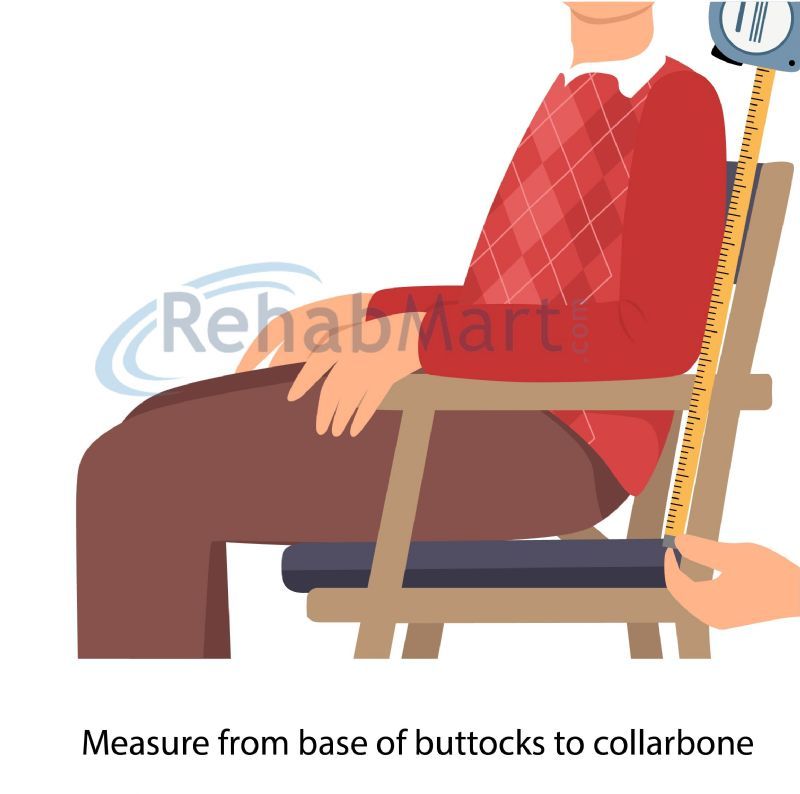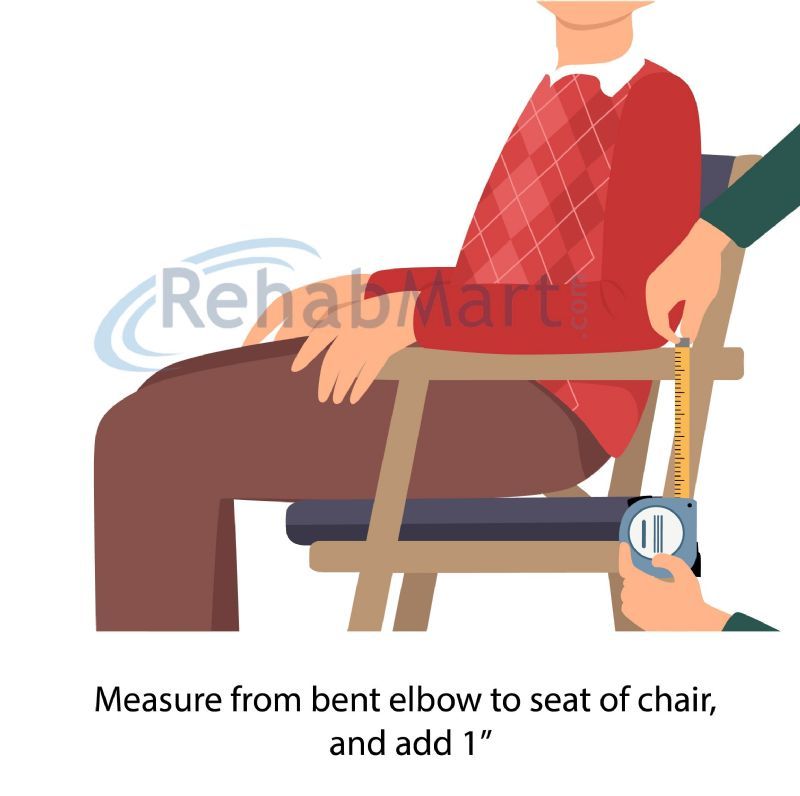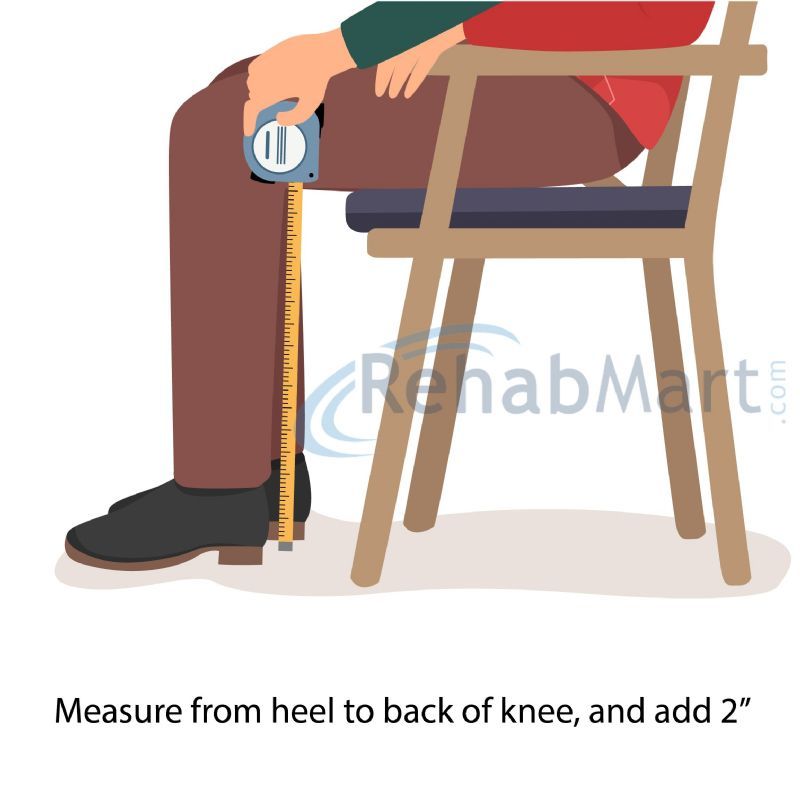 Written by Brittany Ferri, OTR/L
Written by Brittany Ferri, OTR/L
If you are one of the many users who relies on wheelchairs to get around, you know how important it is that this seating device fits well. Choosing the right wheelchair is not a one-size-fits-all process. In reality, there are a range of sizes that must be accounted for during the customization process. This guide explains exactly what dimensions you need and how to measure them!

The key measurements to size a wheelchair are seat width, seat depth, seat height, seat-to-floor height, armrest height, and footrest length. The tools you will need are a hard tape measure, bathroom scale, and chair.
~3.jpg)
You can determine the seat width by measuring how much space there is from one of your hips to the other. To get the most accurate measurement, be sure to include muscle and skin in this area, not just the hip bones.
You will then add 2 inches to this dimension, which allows you enough room to reposition and add cushions or pillows, if needed. A seat that is too narrow will not only be uncomfortable, but you will also outgrow it more quickly if your body changes. Improper seat width can also cause poor alignment, since your body will tense up to fit into the smaller space.
You can figure out the seat depth by measuring the distance from the back of one hip to the back of the knee on the same leg. You will then subtract 1-2 inches, which give your knees a little room to bend as you exit the wheelchair. Please note, that if your wheelchair seat is not deep enough, you can cut off circulation to your lower legs and put yourself at risk for blood clots in the legs and feet.

The seat height is also called "back dimensions", since it details how much back support will be on the chair. If you do not have any back problems or concerns related to core strength, then you may benefit from a seat with a lower back. Most users choose this option, and the standard seat height is 16-inches. However, if you consistently have back pain, stiffness, or decreased motion, it’s crucial that your wheelchair offers stable back support. In this case, it would be beneficial to find a wheelchair that fully supports the length of your back, or perhaps a high back reclining wheelchair could help.
You will need help from someone else to determine the seat height you need, since these dimensions are taken by measuring from the base of the buttocks to the collarbone. This is typical for a standard wheelchair, which does not offer head support. If your doctor has recommended a customized power wheelchair, you will also need this measurement to include the distance from your collarbone to the top of your head.
.jpg)
To determine the seat-to-floor height you need, you should measure the distance from your heel to the back of your knee while you are seated. This measurement ensures that you are comfortable sitting, with your knees bent at 90-degrees.
If you are going to utilize your lower body to self-propel in your wheelchair, you can subtract a few inches from your measurement. In order to self-propel your wheelchair (with the footrests removed), the seat must be the appropriate height so your legs can extend forward and help you propel. Some wheelchairs have a feature called 'hemi-height', which means they have a lower seat-to-floor height, designed for this exact reason. Those types of wheelchairs usually have a dual-axle, which allows you to lower your seat height. Users like this feature if they lack upper body strength, and have a difficult time propelling themselves with their arms.
If your wheelchair height is too tall, your feet could dangle, and it might be awkward entering/exiting the wheelchair. However, rarely do you find a wheelchair with a tall seat-to-floor height. This measurement is mainly important when sizing a pediatric wheelchair, or if you require a wheelchair with a low seat-to-floor height.

Armrests are another important part of a wheelchair that allow users to support their arms. Without armrests, your hands will dangle close to the wheels of the chair. This not only poses a safety risk for someone who might get jewelry or fingers stuck in the spokes, but it also causes blood to pool in the hands and impairs circulation.
Armrest height can be identified by measuring from the seat of the chair to the point of the elbow. Similar to the measurement for seat width, you will add 1 inch to this number so that there is some room for adjustment.

The length of the footrests, also known as front riggings, is the same measurement as seat-to-floor height. However, for footrest length, you will need to add 2 inches to this number. This is because the footrests should be positioned 2 inches from the floor so that you can move properly without dragging them on the ground or getting stuck. If you plan to utilize the footrests on your wheelchair, another important consideration is ensuring the seat is high enough to allow for appropriate ground clearance.
Some wheelchairs have weight limits, which is important to consider for anyone, regardless of their stature. Some wheelchairs have a smaller frame and are, therefore, more suitable for those of a smaller height and weight. Other standard wheelchairs can typically accommodate someone between 250 and 350 pounds. Bariatric wheelchairs are indicated for anyone who exceeds this weight range. Make sure you weigh yourself, and purchase a wheelchair that can accommodate your weight.
According to the Americans with Disabilities Act (ADA), all doorways should be 32 inches wide to accommodate wheelchair users. This is an important accessibility feature for community structures and your workplace, but it’s even more crucial for your home.
Before getting your wheelchair, don’t forget to measure doorways within your home. If these spaces are too narrow, you will need to have someone widen them before you begin using your wheelchair. Bathroom and hall entries are the spaces that most often need to be adjusted, but other parts of your home might need similar modifications.
Footrests are an important part of a wheelchair for some users who do not have the leg strength or motion to self-propel their chair. There are several different types of footrests to accommodate varying needs. Standard footrests are commonly found on basic transport chairs, as they provide leg support via a foot plate at a fixed angle and height with no option for adjustment. This is best if you only need your wheelchair (and the corresponding leg support) for a short period of time or if you can suspend your legs independently, if needed.
Elevating footrests are ideal if you have cardiac conditions or circulation problems and need to prevent blood from pooling in your legs when seated. The length of elevating footrests can be adjusted via a separate lever, and they also have padding that supports the leg at the calf as the foot rests on the foot plate. For this reason, elevating footrests are a good choice if you want to control elevation at any given time.
Articulating footrests look similar to elevating footrests, but they elevate gradually as they are moved up and down. They are also helpful if you have circulation concerns, but they can be more difficult for you to independently adjust. If you choose this option, you may need caregiver or family assistance to manage them. Articulating footrests are also good if you need to achieve a specific angle of elevation per doctor’s instructions (for example, after an ankle fracture that requires a specific aftercare plan).
Whether you feel you need them or not, armrests allow you to sit upright in your chair while also keeping your body evenly positioned. They can also be of help when you are repositioning yourself in your chair and want support on the side.
Full-length armrests are the standard option, which is suitable for most people. You also can opt for desk-length armrests. These are shorter and allow you to pull up to a countertop when eating dinner, using the computer, or completing other tabletop work.
The right wheelchair is one that keeps you in an ergonomic sitting position, which means that it must offer proper pelvic support and trunk stability. If you have specific recommendations from your doctor or therapist regarding pelvic support, you may want to look into a certain type of wheelchair or accessories to assist you.
A standard cushion comes with most wheelchairs, but some people need pressure relief wheelchair cushions if they are at risk for pressure ulcers (or bed sores) on their buttocks. Cushions are a vital accessory for most wheelchair users. But keep in mind that most cushions will change your measurements for back height. This is an important consideration when taking measurements. It’s equally as important to carefully assess your options for cushions as it is for wheelchairs. You can use our wheelchair cushion reviews when selecting the cushion that is right for you.
As you can see, ordering a wheelchair requires a bit of forethought on your part. But once you have these simple measurements in hand, you can get a seating device that enables you to interact more easily and comfortably with your environment.
Thank you for learning more about this important topic! If you are interested in other rehab equipment articles, visit Caregiver University for more articles. Otherwise, check out our entire selection of Wheelchairs For Sale.

Brittany is an occupational therapist who has worked in a variety of rehab facilities. She has always expressed an interest in patients’ internal motivation for therapy and the use of assistive devices, which led her to pursue a PhD in Integrative Mental Health. This research-based training has also led her to develop her writing career to educate patients of all ages on how to improve their health. Brittany has published four books, written over 300 articles, and has been quoted in media outlets such as WebMD, Healthline, and NBC News.